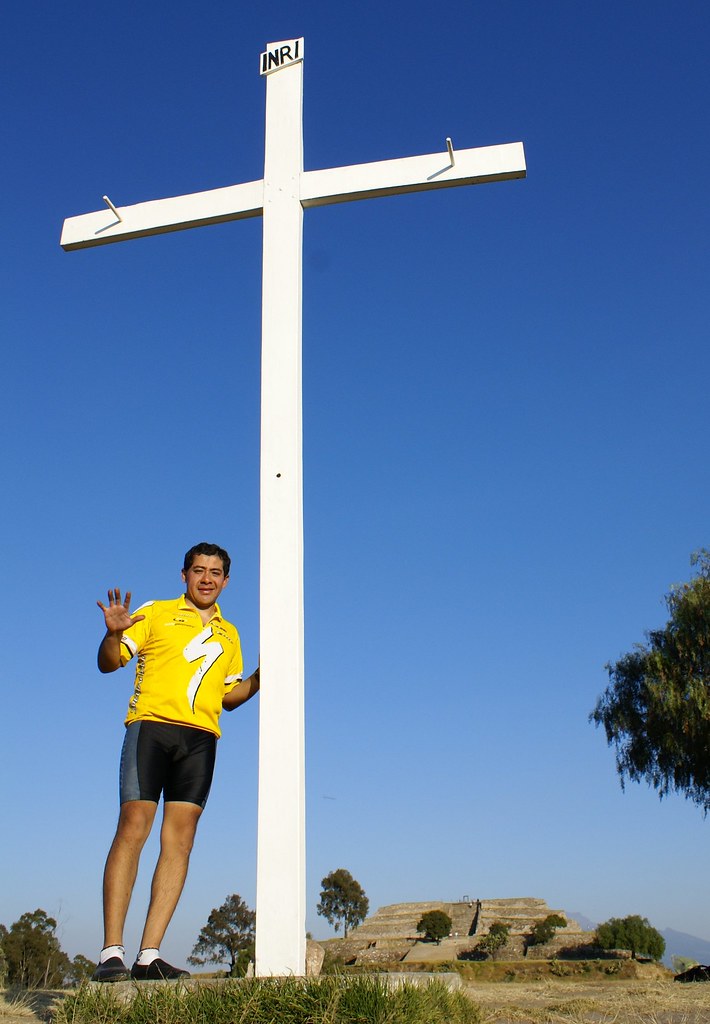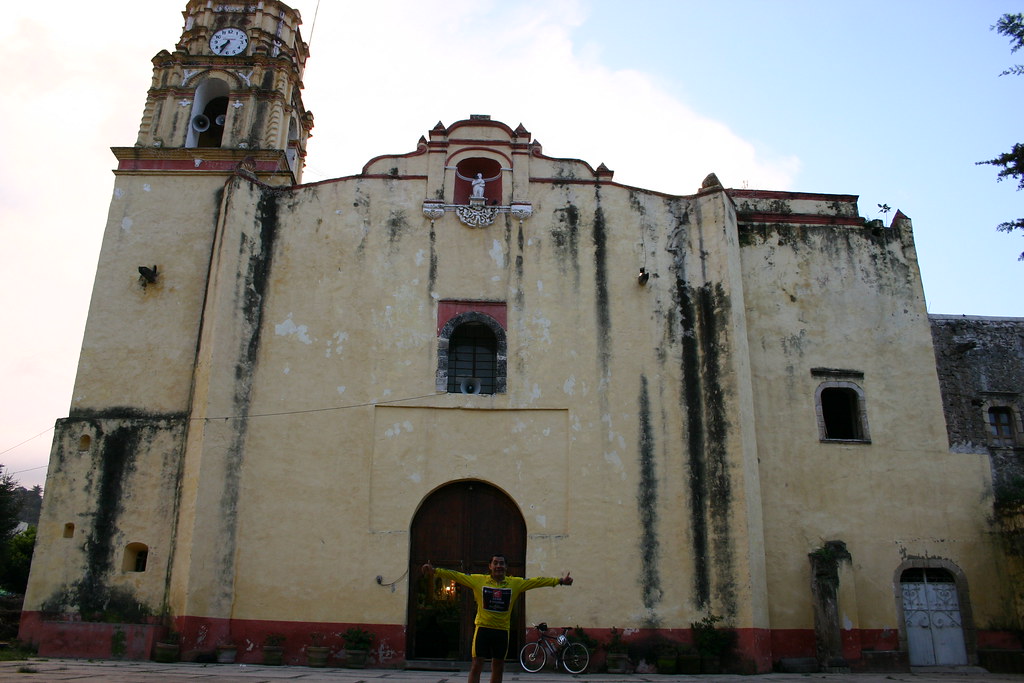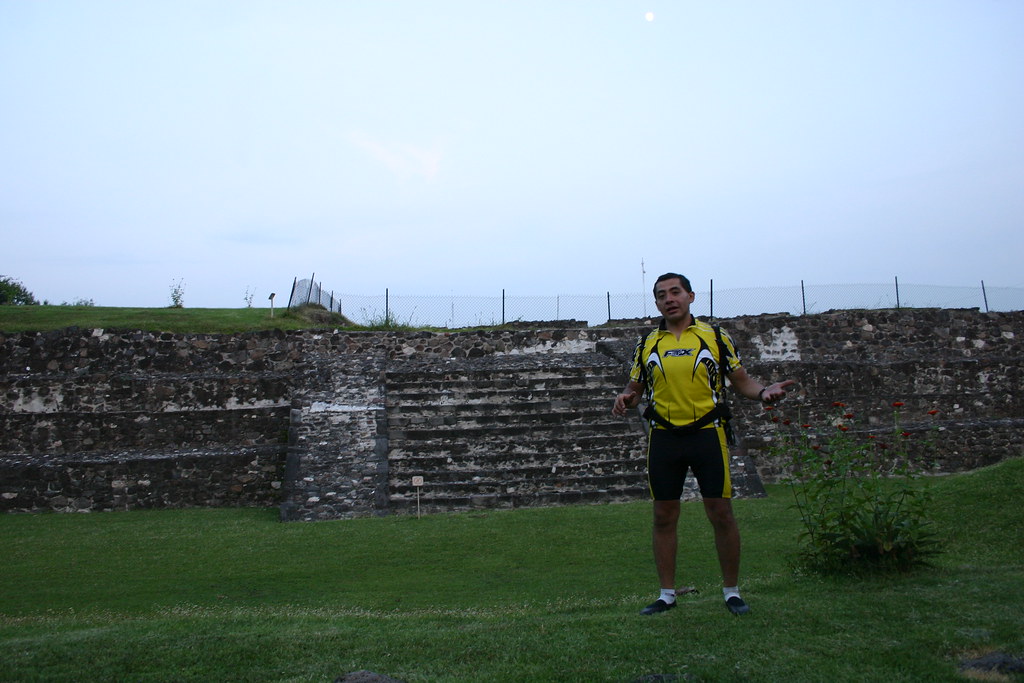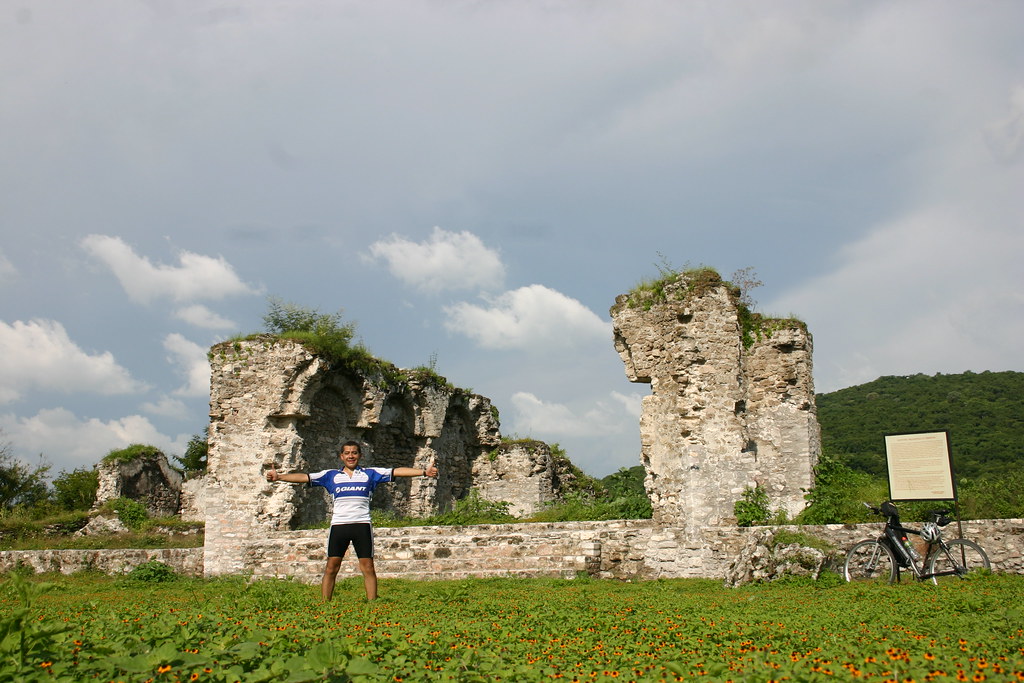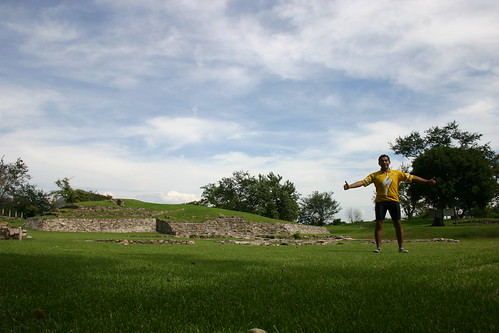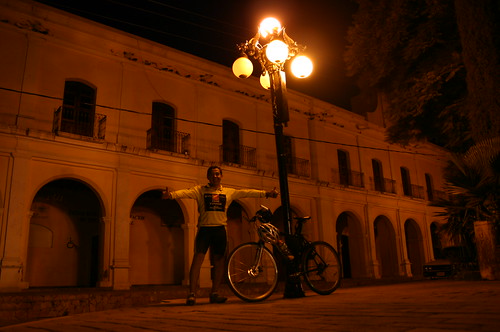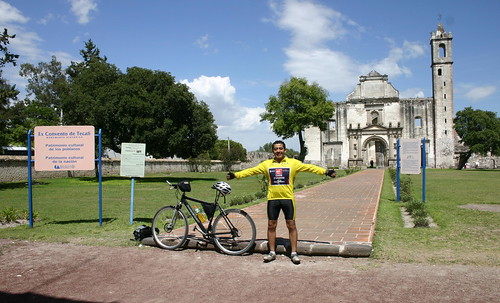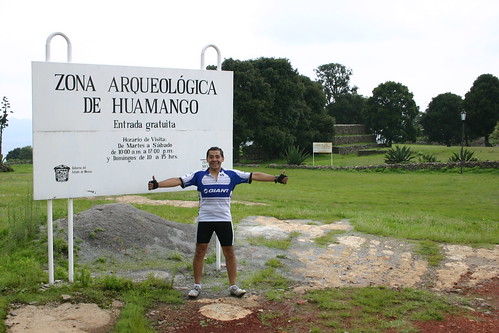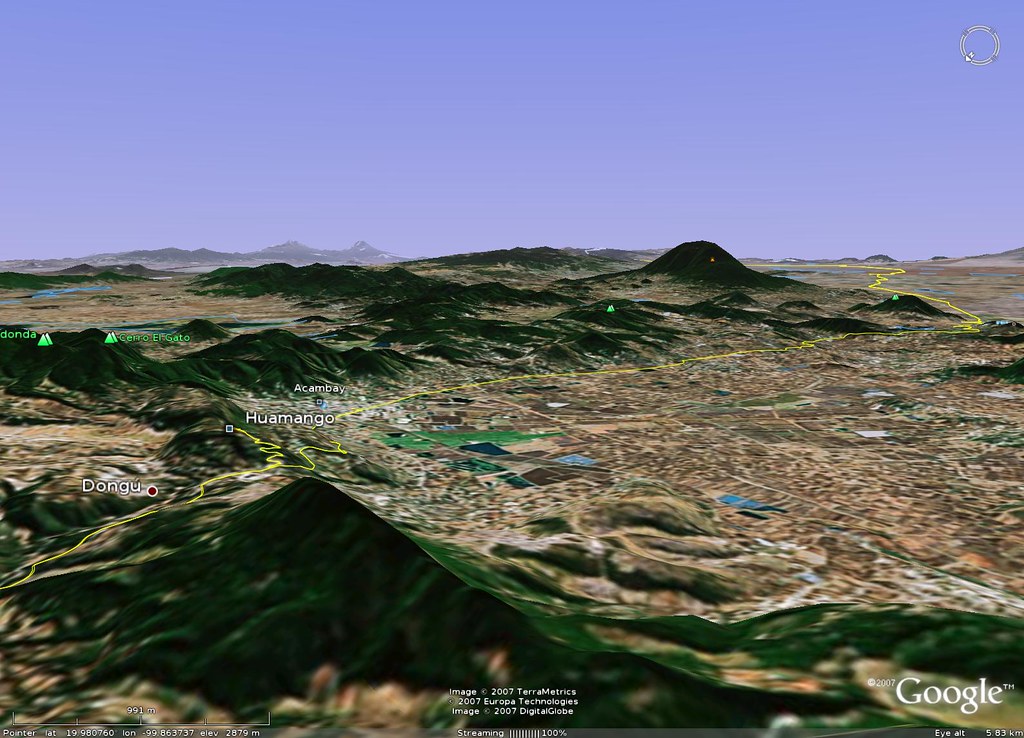Since a long time ago, I had desired to ride the
Convents Route (built in the XVI century) in the southern state of Morelos. But I had first to complete the visits to the archaeological sites of several pre-Hispanic cultures in Central Mexico (as a mean to pay a tribute to the original inhabitants of these lands). Now, as it seems like I have already completed the visits to almost all archaeological sites in the states of: Mexico, Morelos, Puebla, Tlaxcala and Hidalgo, I could finally engage in this long desired route through the eleven convents in Morelos that have been declared by the UNESCO as World's Cultural Heritage.
In last week ride, I could
visit three of those convents (since they were in my route to the Yautepec archaeological site), namely, the Convents of: Totolapan, Tlayacapan and Oaxtepec. The Convent of Tepoztlán has already been
visited in a previous ride this year. In this way, I could arrange a route to know the remaining seven convents, the Convents of: Atlatlahucán, Yecapixtla, Ocuituco, Tetela del Volcan, Hueyapan, Zacualpan de Amilpas and Jantetelco.
The route taken involved arriving firstly at the convent of Atlatlahucan via Amecameca, and then riding down to Cuautla (Morelos). In order to arrive at Amecameca, I decided to take a new route to me, riding this time through Tenango del Aire and Ayapango. In this way, I could avoid climbing an extra 100 m that is required in the toll highway to Amecameca. But I still used the Puebla toll highway in order to bypass Chalco, deviating from it at the Cocotitlán branch.
So, let's start this report from where all things get started: at the beginning. The ride began at the really late hour of 10:40. I took Fray Servando Av. (where I had the opportunity to observe the cyclists riding in the ongoing Ciclotón in Mexico City) to gain access to the Zaragoza Av. Zaragoza is a long and wide avenue that converts itself later in both toll and free Puebla highways (at Los Reyes junction). At the intersection of those two inter-state highway stands what is currently a gigantic traffic jam covering several kilometers in length (owed to the building of an elevated pass). Once crossed that mess, I took the toll Puebla highway, and left it just before the Huixtoco toll station, in order to take the Chalco branch. After crossing the Puente Colorado toll station, I continued cycling along the toll Chalco highway, but at the Cocotitlan deviation I branched out south in order to arrive at Temamatla, Tenango del Aire and Ayapango. I should add that the road between Ayapango and Amecameca is one of unsurmountable beauty: a clean and pristine countryside with no sight of towns, almost plain, and surrounded at both sides of the road by colourful flowers and green grass: an idyllic scene, in fact.
Arriving at Amecameca, I took the Cuautla free highway, passing on my route the towns of Ozumba and Tepetlixpa. Tepetlixpa is the last town before the descent towards Cuautla starts, so, if you need to purchase water or food, please do it there. On my way down to Atlatlahucán, I crossed the town of Nepantla, place where Sor Juana Ines de la Cruz (the best writer in her time) was born in 1651, and also a destination of
one of my previous rides. At my arrival to the Atlatlahucan branch, I exited the Cuautla highway and cycled upwards to Atlatlahucan, arriving promptly at the convent, located in the main square of the town.
The San Mateo Convent of Atlatlahucan features an austere yet imposing all white monumental facade, being probably built at the top of a pre-Hispanic temple. As a result of this construction, the convent lies above the rest of the town. When I was there, a funeral procession (coffin included) was arriving at the church, so I had the opportunity to closely observe this funeral mass. A musical band accompanied the funeral, playing some local marches. In fact, that was a busy church, since it seems that just previous to my arrival, another mass, this time maybe from some fifteen-years party, had been just finished (by the looks of the gathered people in front of the church). I should add that, being that day September 30th, the entire state of Morelos was in party mood, as that day marks the birthday of Independence War hero and leader: Jose Maria Morelos, whom with Miguel Hidalgo, is one of the founding fathers of Mexico (in fact, Morelos took the leadership of the Independence War at the hanging and death by the Spanish crown of Miguel Hidalgo). So, I had the sheer luck of being able to observe all the convents visited along the route (Atlatlahucan included) being decorated by a multitude of floral crowns and arrangements. The convent houses also some wings that appear to be abandoned, with no maintenance at sight, just the facade is stunning white. The atrium of the convent is enormous and well maintained, featuring a pleasant green grass cover.
Once finishing my visit to that convent, I cycled again towards the Cuautla highway, and four kilometers down after the junction, I arrived at the Yecapixtla branch, which I took and started the ascent, from 1500 m at the branch, all the way up to Tetela del Volcan, at 2250 m. But I had first to arrive at Yecapixtla.
The San Juan Bautista Convent of Yecapixtla (built in 1535) features an equally imposing and gigantic facade (albeit a little less white), with a Gothic rose above the door, being the arch of the door also beautifully sculpted in stone, depicting some heraldic and angels. The atrium again was immense (albeit a little less maintained). But the interior of the church was magnificent, beautifully painted and decorated, with a precious white altar. The convent itself features no more than a single floor, but the walls that compose the garden's arches are precious, as they present beautifully preserved paintings and inscriptions of several religious people (as saints and popes) plus icons, along with Bible passages (like the Cruxifiction). In fact, not only the walls of the arches, but also the whole ceilings are covered by geometric figures (like octagons and crosses). The garden seems to feature a well in its middle.
After one hour of visit (curiously, I averaged one hour for each convent visit), I decided to resume the ride, continuing cycling upwards, this time towards Ocuituco, where 300 m of steep climbing were required to arrive at this town.
The Santiago Apostol Convent in Ocuituco features a beautiful ancient yellow facade, with a single bell tower. Time has left its mark in that facade, but no without a reason: this convent was the first to be built in America by the Augustine order in 1533 ! As the town was in party mood, the convent door had been enriched with a floral arch surrounding the entrance, depicting several religious passages. As the mass was beginning, I could observe several people arriving at the church, speaking in Nahuatl. Also the dressing of several women (mostly the older ones) started to resemble different from what we could term now
contemporary fashion, more in the style of the original peoples of those towns. The interior of the church is painted in a smooth peach color, presenting a modest yet imposing white high altar. The interior of the convent features two floors, with a water spring in the middle of the garden. Its walls are painted in white, while the curved ceiling is decorated with geometric designs. The atrium of the church features a big cross, decorated by a floral arrangement. Outside of the convent, a picturesque (painted in strong blue) local market can be appreciated.
It was time now to continue cycling upwards, this time to the town of Tetela del Volcan, being required to climb almost 400 m to arrive at this town, located at an altitude of 2260 m. The ascent from Metepec to Tetela is a particularly steep one, specially inside Tetela (the Convent is located in the highest point in Tetela). I had to climb all the road inside Tetela standing on my pedals, as I was so exhausted (and the grade of the ascent was so cruel) that by just sitting on my bike I was not going to make that climb. But alas ! When I arrived finally at Tetela (at 19:15) ... there was a big party in the town ! But first business. So I headed directly to the convent.
The Convent of San Juan Bautista in Tetela del Volcan features what looks to me as the most austere facade of this series of convents. It is painted in a yellow peach colour, presenting only one bell tower (but its clock is working). The church interior is painted in pristine white. I has scarcely time to take the last shots of the convent, as it was now 19:30 and the darkness was looming. Once taken the compulsory pictures of this Augustine convent, I decided to turn my attention to a much more mundane topic of interest: the party !
From all the towns along the route that I had made that day in Morelos, Tetela was the place where I could find the biggest party. There was a lot of people gathering in the main square of the town, all taking part in the unconmesurability of
La Fiesta. In that party at Tetela del Volcan (its biggest party of the year) I saw things that I had never been able to observe before. For example: I saw donkeys with floral crowns, which later I was told were part in some donkey runnings . I saw also a children competition, in order to see which child could catch an oil-covered little pig. In fact, there were several of those competitions. I saw another tournament, this time involving climbing an oil-covered mast, which at its top had prizes for the winners. I saw a lot of yet unseen things to me. That was my biggest reward: to know unknown things to me. There were a lot of fireworks also and another contest, this time involving the riding of a mechanical bull. Remarkably, I also had the opportunity of taking some photographs of the Queen of Tetela, meaning the victorious lady (and accompanying princesses) in the beauty pageant of Tetela del Volcán. Beautiful ladies indeed.
At 22:00 I had to make up my mind, since it was too late to do any other thing different than looking for a place to sleep. The party was going to continue all night long (till 04:00 next day), so I must find a hotel, just before the accommodations were fully booked. I decided to pass the night in Tetela, since from this point I could continue the route of the Convents the next day, and even, return to Mexico City cycling, but I had to be well rested for that matter. So, I started asking for directions for a place to sleep, and fortunately, I could find a hotel no more than three blocks away from the center: the St Valentin drugstore. Really, that drugstore (coupled with its sister clinic and laboratory) featured also a small yet clean hotel: the hotel
Mirador del Volcan. So I ringed and ringed and finally a clerk got out and listened to my need, offering me a room for 150 pesos, which I promptly took. Once solved the accommodation problem, I had to sort out the next question: What to eat ? After leaving my bicycle (as I always do in these occasions) and the rest of my cycling equipment in my room, I went to the center of Tetela to purchase some food (mainly cheese, meat, soda) in a convenience store. I could also buy some local fruits in the street. Once armoured with my dinning/breakfast, I returned to the hotel. I would like to had been able to attend the ongoing party (and dancing ball), but I had to sleep for the next day cycling. All night long the dancing music continued (till 04:00 next day), the fireworks also continued their spectacle, and, after the music had subsidized, some pistol shots were listened, as is customary for those town parties :-)
I woke up next day at 08:00, just in time to take some clear photographs of the Popocatepetl volcano (difficult to see later, since it gets covered by clouds early). Once I had taken a bath and arranged my bicycle and cycling equipment, I started the ride at about 10:00, this time with the goal to reach the town of Hueyapan. So I climbed back to the center of Tetela del Volcan and took the sinuous descent road to Alpanocan, in a tip of the eastern state of Puebla. This town features a modest yet interesting church painted in pink. After briefly visiting Alpanocan's Municipal Palace, I resumed the trip to Hueyapan, entering again in the Morelos state. The road between Alpanocan and Hueyapan is one of sinuous and steep ascent nature, requiring climbing 250 m to reach Hueyapan. In Hueyapan (farthest point in our route) I found its Convent closed. So I had to rely on photographs taken from the door of the convent. That town is known for its prominent use of Nahuatl as a common language. Unfortunately, as I arrived there on Monday, all the people that use to arrive at the market were absent at that moment, so I could not grasp any hint of spoken Nahuatl. The only people I found on the plaza were secondary school students, whom with high probability would have never spoken a word of Nahuatl, being its use confined to the older generations. Once I finished my visit to the picturesque town of Hueyapan, I resumed my trip, this time cycling downwards to Tlacotepec (where I stopped a little to admire its beautiful white church) and later to Zacualpan de Amilpas.
The La Inmaculada Concepción Convent in Zacualpan de Amilpas is one of the most beautiful convents I could appreciate in the whole trip. The convent itself is maintained in pristine conditions, being built with some pink stones resembling pink marble. Its facade its superbly clean. The convent even features two bell towers (something not so common). The church interior is every bit as beautiful as its exterior, all in white painted with simple yet elegant paintings as decoration. The walls of the arched corridors of the convent feature clearly restaurated frescoes, depicting religious images and saints. The convent comprises two tiers, featuring a central yard, complete with a water spring in its center.
Next point in the route was the Convent of Jantetelco, so I cycled downwards for the last point of interest in the route, arriving promptly at Jantetelco. Unfortunately, the convent was closed for the public visits, as its architectural integrity has been compromised by the fall of a lighting a couple of months before. The fallen lighting was so strong that one of the church vaults had broken under the force of the lighting, rendering the whole church structure unstable, and now prone to fell over its occupants. For this reason, the masses in that church are being carried outside as open air masses.
Being Jantetelco the last point of visiting interest along the route, I decided trying to do a promptly return to Mexico City. For this return to be made, first thing to be done was to arrive at Cuautla. So, from Jantetelco I cycled to Amayuca (where I could take a couple of shots of its beautiful church), and then, I took the Cuautla highway, a nice asphalted and well painted mostly plain highway. At my arrival to Cuautla, I branched to out to the Mexico City free highway, via Chalco. This return leg to Mexico City involved a 1150 m climbing. Along the uphill road I crossed the Yecapixtla and Tlayacapan branches, arriving later back at Nepantla. Uphill I crossed Yecapixtla again, and a little later I could arrive finally in Amecameca, at 19:00.
As soon as I arrived at Temamatla, the darkness was complete. I had thought that once reaching back Amecameca, the return leg to Mexico City was almost completed, as all the climbing was now behind me. But alas ! I hadn't taken into account that darkness was looming, so what is under normal (diurnal) conditions a pleasant ride, turned out to be a highly extenuous and tiring cycling ride once the night had set on. Having no lights, I had to continuously try to guess and infere where I could find holes along the pavement. Determined to use as much public electric lighting as possible, I decided to cross the entire (urbanized) Chalco Valley. Once crossed the Chalco Valley, I could ride along the free Puebla highway trough Ixtapaluca and later Los Reyes, where I could finally reach the Zaragoza Avenue. Cycling along this road, I could finally arrive at the TAPO bus terminal, near the center of the city. From there all I required to arrive at home was a short ride south along Union Congress Av, and voilá: I was finally back at home's security, after a three hundreds kilometers long ride (and a three thousands meter climbing) !



